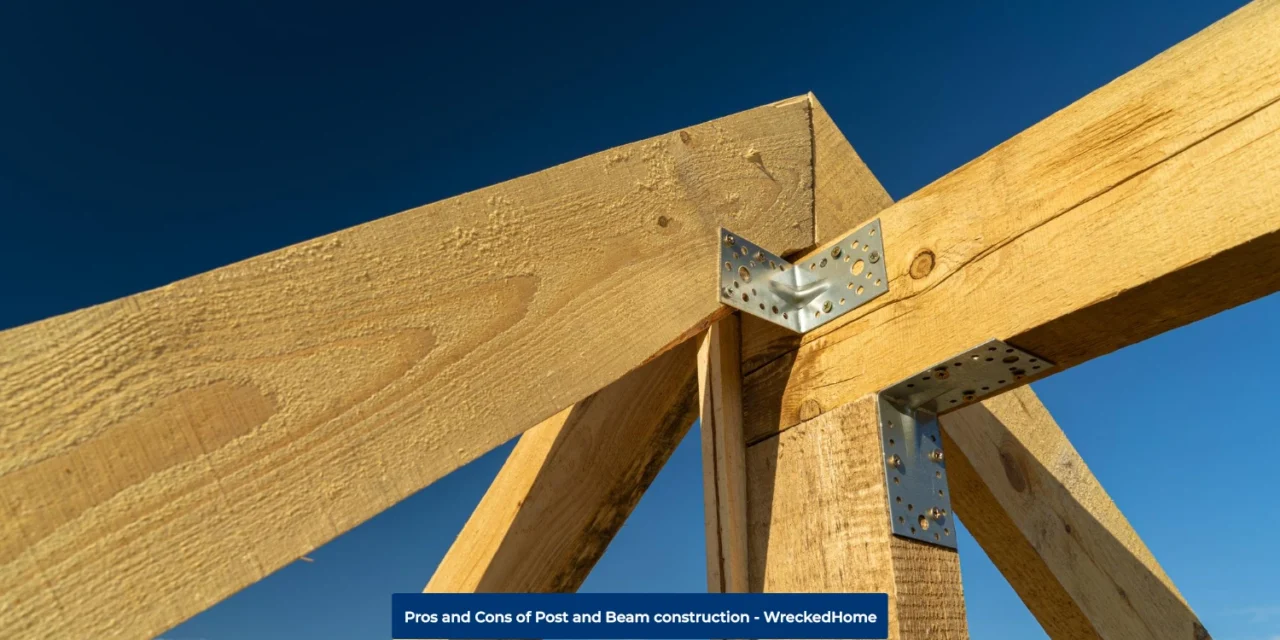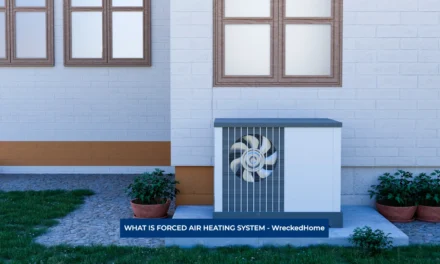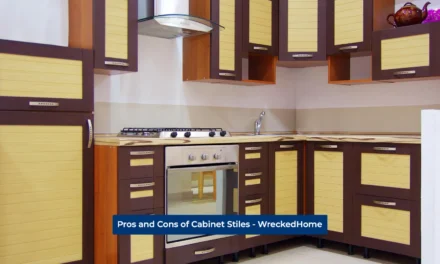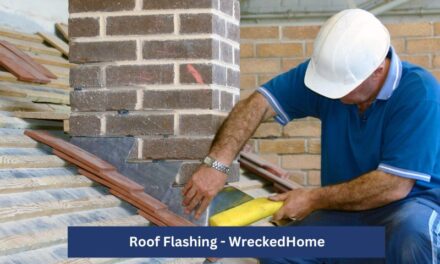Post and beam construction, is as ancient as human civilization itself. The root cause of its popularity is to serves as a testament to the ingenuity of early architects and builders.
These are characterized by large vertical wooden posts supporting horizontal beams with the incorporation of metal elements. They also are used to create free space in construction projects. The resulting skeletal framework provides both aesthetic beauty and foundational strength, to make homes modern architectural styles.
In today’s rapidly evolving wood construction landscape, where efficiency, sustainability, and design aesthetics is known, a crucial element is understanding the pros and cons of the post and beam construction is vital.
Homeowners, architects, and builders pay attention towards the method that aligns with contemporary needs and preferences. The post and beam construction aligns with their vision. In this guide you will get the proper knowledge about post and beam construction. Also, you will see how its beneficial and when you should avoid to use it. Without waiting, let’s embark the pros and cons of post and beam construction. We will also discuss both functionally and aesthetic aspects.
What Is It?
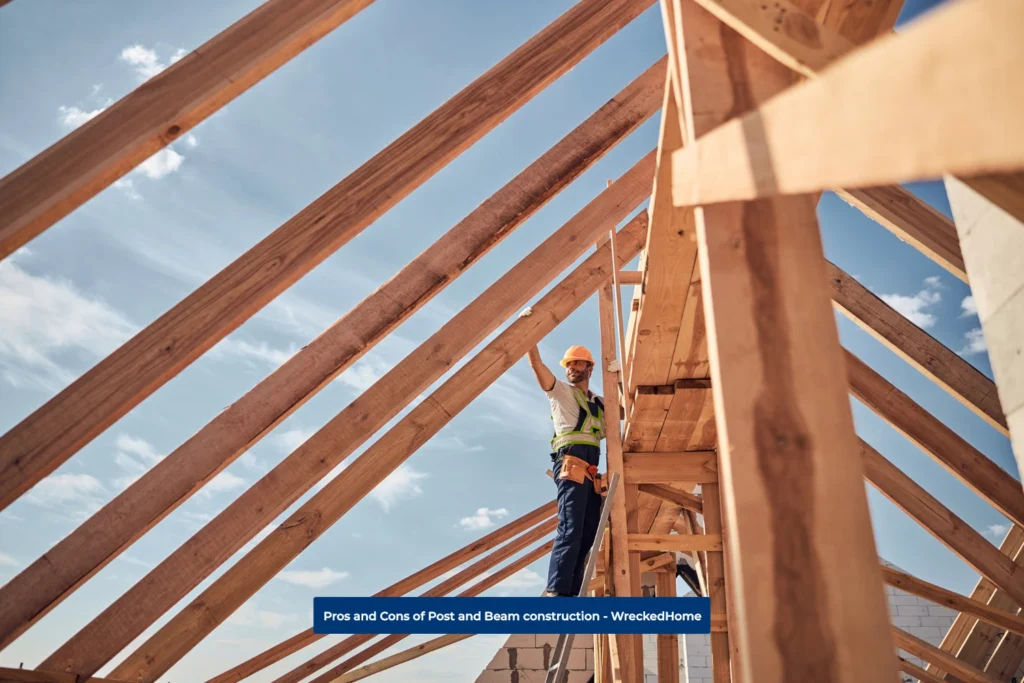
Are you familiar with post and beam construction? It is an age-old building method distinguished by its use of large vertical posts and horizontal beams to form a supportive skeletal structure. Post and beam construction consists of wood and some metallic elements. The metallic element adds extra durability and support in this post and beam construction frame than timber frame.
In this durable structure the weight of the structure is carried by this timber framework. This make it more aesthetic and the essence of post and beam construction lies in its simplicity.
The vertical posts, acting as the primary load-bearing elements, act as a linker and transfer the weight of the building to the foundation for grip. The horizontal beams, bridging these posts, distribute load evenly and define the structure’s spaces. Together, both post and beam create a strong and sturdy skeletal framework that is the base for any building.
Besides its structural attributes, post and beam construction adds a touch of rustic charm, reminiscent of barns and log cabins that enhance look with contemporary designs. This construction method is used for large open spaces, free from intervening load-bearing walls. It also allows flexible interior layouts.
Pros of Post and Beam Construction
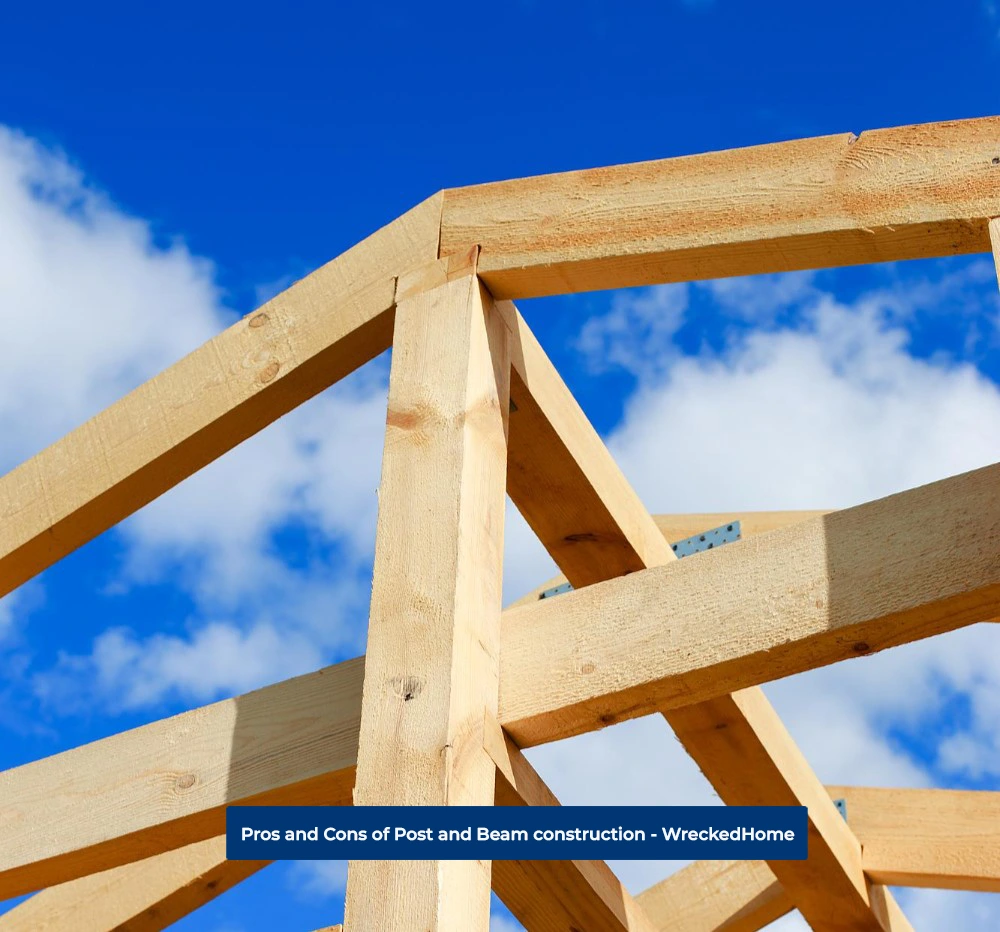
The wood and metallic combination makes a frame that isn’t entirely wooden. It has an aesthetic appeal due to wood and durability. This is because of metal. The post and beam construction as an ancient frame work offers several benefits that are
1. Aesthetic Appeal
Post and beam is not just a method of construction; it’s an art form. One of its primary attractions is the unique and timeless look that adds elegant aesthetics to any building. The exposed wooden beams and posts are made up of beautiful, rich timber.
That is used to create a warm and inviting atmosphere. This rustic charm reminds many of old-world structures that have memories of ancient age and integrate this taste with modern and contemporary designs. This combination allows for flexibility in design and layout.
Additionally, the nature of post and beam construction allows home owners to create spaces tailored to their needs and desires. The absence of load-bearing walls in the interior opens up a world of design possibilities that rage from multi-function rooms to expensive lavish living spaces.
2. Structural Integrity
When it comes to strength and durability, post and beam constructions is priority one due to inherent design that provides durability and longevity. This method ensures that structures last for generation to generation without any cramps. The massive posts and beams, once locked together, form a cohesive unit that can bear any type of conditions without damage.
This strong structure enables it to withstand natural calamities like earthquakes. In seismic zones, this slight movement can make all the difference, prevent from any collapse to save lives and properties.
3. Environmental Benefits
In an era where sustainability is paramount, post and beam construction is a source of eco-friendly sustainable materials like timber. Wood, a renewable resource, is environment friendly due to less carbon production as compare to other building materials. When sourced responsibly both post and beam construction can lead to less wastage. Every beam and post is cut to exact measurements that ensure optimal utilization of materials and minimizing scrap. Check out our Energy Efficient Products For Your Home Here!
4. Flexibility in Modifications
One of the most significant advantages of post and beam structures is its modified and flexible structure with extended life. Since the building’s weight is predominantly supported by the posts and beams builder or home owner can easily do adjustment in building with time to time. Whether you want to add a new room or expand an existing one? With use of post and beam construction structure you have ease to do anything.
The home with flexible frame work can adapt without extensive reconstruction, saving both time and money.
Visit our store for 10% off our Tools here.
5. Thermal Performance
The timber used in post and beam construction comes with inherent natural insulation properties. Wood is a poor conductor of heat, that keep home cooler in summer and warm in winter.
This natural temperature regulation can reduce the reliance on artificial heating and is cost-effective that lower electric utility.
Moreover, when combined with other modern insulation materials and techniques, the energy efficiency of post and beam built homes increase. With rising energy costs and a global push towards reducing carbon emissions, these are best source of environmental friendly and the energy-efficient homes.
Cons of Post and Beam Construction
Both post and beam are basic elements that provide a natural and environmentally friendly architecture. But, with the pros of energy efficiency, temperature control mechanisms, and flexible support there are some linked cons. These are:
1. Cost Implications
While post and beam construction boasts numerous benefits, it comes with some cost adding implications. First and foremost, there is the potentially higher initial cost that linked with its wooden material.
Quality timber, especially if one is opting for certain premium or sustainably sourced woods is higher in price and not available commonly. Additionally, given the specialized nature of the construction technique, it requires experts to fit this structure that add labor cost.
With the passage of time, there are maintenance costs over the long term that needs to consider. Timber, while durable, needs regular care to maintain its beauty and structural integrity due to which you need to have some quality materials. This could mean periodic treatments to prevent or mitigate damage, which increase life span of structure but add extra cost.
2. Specialized Labor and Knowledge
The art of post and beam is not easy to handle so it requires experienced craftsmen. These individuals have typically undergone years of training and expertise to deal with this wood structure. Sometime its difficult to find specialized labor that can fix it properly. This potential scarcity increase the demand of skilled craftsmen that can lead to increased labor costs.
3. Pest Vulnerability
As you know this all wood material structure is prone to pests, particularly termites and other wood-boring insects. These pests can cause substantial damage, undermining the structural integrity of the building if you don’t pay attention and left unchecked.
For homeowners, this necessitates regular inspections and, in some cases, it require proper treatment to avoid pest. These treatments can be both time-consuming and costly, that require long run home care. If you find yourself with an infestation, don’t hesitate to hire a professional. Find a Pro Here Today!
4. Maintenance and Upkeep
Timber, is an organic material that is prone to decay over time. Therefore homeowners can see structural changes and damage. The elements like moisture, fungal growth, or even simple wear and tear can affect the wood health badly that in result wear or tear building aesthetic and durability.
Compared to alternatives like brick or masonry structures, post and beam homes might need more care and time. On the other hand brick or stone might need occasional cleaning.
5. Limitations in Material Choice
The very essence of post and beam construction is based on the use of timber. This dependence means there is a need of sourcing quality timber. That is difficult. In regions where quality timber is not available it becomes challenge to sourcing it.
Also its difficult to protect it from environmental impact that require extra care. Therefore it can be source of hurdle for people looking for quality, sustainability, and affordability. It impact project’s budget or timeline badly.
Conclusion
Post and beam construction, with its heritage and distinctive aesthetic touch, is a unique blend of structural integrity and design flexibility. In the ever-evolving landscape of construction and architecture are offer environmental advantages to architectural freedom.
By weighing the pros and cons of post and beam construction, stakeholders can craft spaces and use it according to environmental ethos, and practical needs. You can use it in any temperature due to its heat resistance ability.
If you want to add both durability and natural environment with aesthetic appeal then post and beam construction structure is must go option.
For any repairs, installations, builds, or questions; We recommend you to hire a professional. Find A Pro Near You Here!
FAQS
What is the meaning of post and beam?
Post and beam construction refers to a method that consists on larger timber with vertical and horizontal position in building respectively. It involves specific styles like timber framing, that join the edges and give support to building.
What is the strongest structural beam?
The I-beam is considered the most durable beam the strength is due to the vertical direction. It also includes consistent performance of timber in other orientations.

